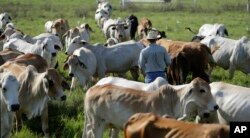When you consider all life on Earth, billions of human beings are a relatively small number when compared to trees, earthworms or even viruses.
But humans really know how to use what little power we have, a new study found. The study is said to be the first of its kind of the effect of life forms on our planet.
Humans only add up to about one ten-thousandth of the life on Earth, the study found. That estimate is based on the dry weight of the carbon that makes up the structure of all living things, also known as biomass.
The Associated Press says the planet’s real heavyweights are plants. They outweigh people by about 7,500 to 1. In fact, plants make up more than 80 percent of the world’s biomass, the study found. The findings were published May 21 in Proceedings of the National Academy of Sciences.
Bacteria are nearly 13 percent of the world’s biomass. Fungi — things like yeast, mold and mushrooms— make up about 2 percent. These estimates are not very exact. The real numbers could be more or less, but they give an idea of proportion, noted Ron Milo, who was lead writer of the report. Milo, a biologist, is with the Weizmann Institute of Science in Israel.
“The fact that the biomass of fungi exceeds that of all animals sort of puts us in our place,” said James Hanken, a Harvard University professor. Hanken, a specialist on evolutionary biology, was not part of the new study.
Still, human beings have an outsized influence on other creatures, the report said. Domesticated cows and pigs outweigh all wild mammals by 14 to 1, the study found. The world’s chickens are triple the weight of all the wild birds.
Instead of children’s books about elephants and lions, a more honest representation of Earth’s animals would be “a cow next to another cow, next to another cow next to a chicken,” Milo said.
He and the other researchers took studies that looked at biomass for different life forms and combined them. They then considered the effect of climate and other environmental issues to come up with a planet-wide look at the effect of life on the planet.
Removing water from consideration and measuring only dry carbon made it easier for scientists to compare life forms. About one-sixth the weight of a human is dry carbon. Humans are about two-thirds water.
“Even though short in numbers, we have managed to throw a lot of sand in the air and mess up a lot of things,” noted Harvard University biologist E.O. Wilson. Wilson was not involved in the study.
I'm Lucija Millonig.
The Associated Press reported this story. Susan Shand adapted the report for VOA Learning English. George Grow was the editor.
_______________________________________________________________
Words in This Story
earthworm– n.a long worm, a creature, that lives in wet soil
fungus- n.any one of a group of living things (such as molds,
mushrooms, or yeasts) that often look like plants but have no flowers
yeast – n.a kind of fungus that is used in making alcoholic drinks
proportion– n.the relationship of one part to another
evolutionary – adj.of or related to the theory that all living things have come from other life forms that existed in the past
triple– v.to make three times as great or as many
mammal– n.a warm-blooded animal that produces milk for its young
domesticated– adj.trained to accept the care of human beings
manage– v.to make and keep; to have control of
mess – n.som









